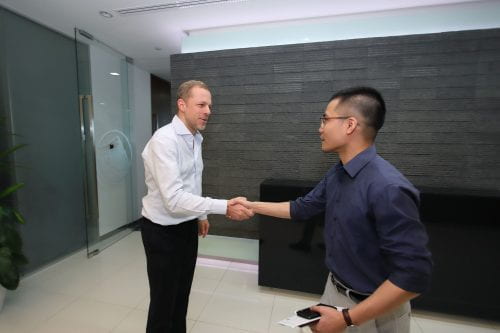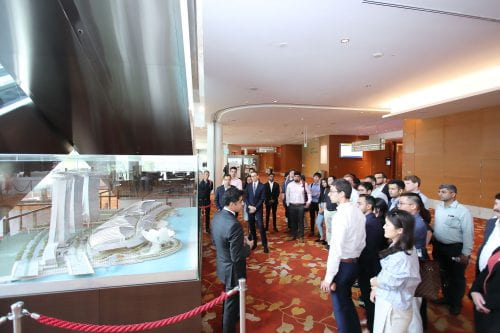
The Cornell Baker Program in Real Estate Class of 2020 kicked off its international trek in Singapore on Monday, January 6th, 2020. Singapore’s phenomenal urban transformation since its independence in 1965 has been internationally recognized as a case study in the advocacy for and potential of a strong, centrally planned and state-backed guidance of real estate development. The students had spent the prior semester studying Singapore’s approach and contrasting it against others both in the region and internationally. The first stop of the trek, at PGIM Real Estate, immediately offered students an immersion into the dynamics of the local market and Singapore’s importance as a hub through which many in the international community deploy capital across Southeast Asia.

Managing Director David Fassbender welcomed Baker students to PGIM’s office for a sit-down discussion of PGIM’s Asian business. Mr. Fassbender is primarily responsible for the operations of PGIM’s value-add Asia real estate funds. Joined by Cuong Nguyen, Head of Investment Research – Asia Pacific, the two walked students through current market trends and discussed PGIM’s various approaches to investing across the region. The persistence of the longest real estate bull-market in recorded history has created an interesting atmosphere amid global real estate investors. Asset prices are at levels not seen since prior to the Global Financial Crisis, and Singapore’s market is one of the region’s most expensive. Investment managers have been challenged to find suitable deals in what has become an increasingly competitive market. Benett Theiseira, Head of Asia Pacific, joined the discussion to give an overview of PGIM’s operations there. More money has shifted into real assets as the bull market continues and construction costs have skyrocketed. This combines to inhibit supply growth amid a red-hot property market that has seen valuations continue to rise ever higher.
While competitive market conditions have made finding suitable investments challenging, opportunities still exist. Su Lin Wee, Head of Asset Management – Southeast Asia, joined students to walk through some of PGIM’s re-positioning of Singaporean retail properties. As an island nation with a relatively small manufacturing sector, Singapore’s economy is primarily driven by consumption. The same retail trends that students have become familiar with in the United States have been simultaneously occurring in Asia as well. One advantage which has allowed Singaporean malls to remain strong investments is their frequent location above transit hubs. This deliberate positioning is the result of Singapore’s strong urban planning. Mall owners such as PGIM to confidently invest in property improvements to keep up with a retail environment that is shifting in response to the rise of e-commerce and consumer desire for “experience.” The PGIM team accompanied students to one such mall in the Tampines area that is slated to undergo a major renovation to shift tenants around and open more, smaller retail spaces to meet these shifting tastes. After lunch with the PGIM team, students headed back towards downtown for an exclusive tour of the Marina Bay Sands.

Students were greeted at the entrance to the Marina Bay Sands Expo and Convention Center by Maunik Thacker and George William Roe, Senior Vice President of Marketing, and Executive Director of Hotel Operations, respectively, at Las Vegas Sands Corporation. Opening in 2010 for a cost of approximately US$8 billion, the Marina Bay Sands is one of the most ambitious and well-known casino resort and conference properties in the world. The site comprises over 6 million square feet, including the Shoppes at Marina Bay Sands (1 million square feet), The Sands Expo and Convention Center (1.2 million square feet/45,000 attendees), The Marina Bay Sands Casino (160,000 square feet/600 table games/1,500 slots), and the Marina Bay Sands Hotel (2,560 rooms). Mr. Thacker walked students over to the scale model of the property to give a brief history of the site’s development before splitting students into groups for a tour.

Starting with the Shoppes at Marina Bay Sands, Mr. Thacker walked his group throughout the mall, pointing to the presence of many high-end retailers. The Mall boasts the world’s largest Louis Vuitton store, which sits suspended on a floating island in the bay in front of the mall – surely one of the most unique high-end retail boutiques of its kind. Students were then led through a discrete entrance into the ornately decorated interior of the casino. Due to the Singaporean government’s view on gambling, the presence of the casino is not well publicized – only a few plaques around the mall indicate the various entrances onto the gambling floors. Though foreigners are allowed in for free, Singaporean citizens must pay hefty fees for the same privilege, typically S$150 for a one-time entry or S$3,000 for an annual pass. These fees have not tempered enthusiasm, however, as Singaporean citizens represent approximately one third of all visitors to the property. After viewing the interior of the casino Mr. Thacker accompanied students into the lobby of the hotel and up for a tour of the Sands SkyPark overlooking the Singapore Coast. At a height of over 650 feet, the park features the world’s largest infinity pool, which has quickly become one of the most shared social media posts in the world and has helped cement Marina Bay Sands as one of the world’s most iconic resorts.
 At the conclusion of the tour Messrs. Thacker and Roe sat down with students at the ArtScience Museum for a round-table discussion of the performance of the hotel, operational challenges, and future development plans. Remarkably, the hotel has run at nearly 100% occupancy since opening and today boasts an average daily rate (ADR) of approximately S$600. The resort attracts both high rollers and VIPs thanks to its gaming operations, which further drive sales at the mall, in addition to the throngs of visitors to Singapore who want to spend a day lounging in the SkyPark. To this point, Mr. Thacker pointed out that the average stay at the hotel was approximately 1.5 nights per guest. Interestingly, the average length of stay for a visitor to Singapore is approximately 4 days. Therefore, the majority of hotel guests are staying for a night or two at the hotel in order to get the experience of the SkyPark before heading to more affordable hotels for the rest of their stay. From an operational perspective, Mr. Roe elaborated on the challenges of turning over rooms at such a high rate across a 2,500 room hotel. Recent initiatives have significantly improved room turnover rate by incorporating wireless technologies that provide real-time information to housekeepers so that no extra time is wasted. The result has been the continual customer satisfaction that has sustained Marina Bay Sands’ success.
At the conclusion of the tour Messrs. Thacker and Roe sat down with students at the ArtScience Museum for a round-table discussion of the performance of the hotel, operational challenges, and future development plans. Remarkably, the hotel has run at nearly 100% occupancy since opening and today boasts an average daily rate (ADR) of approximately S$600. The resort attracts both high rollers and VIPs thanks to its gaming operations, which further drive sales at the mall, in addition to the throngs of visitors to Singapore who want to spend a day lounging in the SkyPark. To this point, Mr. Thacker pointed out that the average stay at the hotel was approximately 1.5 nights per guest. Interestingly, the average length of stay for a visitor to Singapore is approximately 4 days. Therefore, the majority of hotel guests are staying for a night or two at the hotel in order to get the experience of the SkyPark before heading to more affordable hotels for the rest of their stay. From an operational perspective, Mr. Roe elaborated on the challenges of turning over rooms at such a high rate across a 2,500 room hotel. Recent initiatives have significantly improved room turnover rate by incorporating wireless technologies that provide real-time information to housekeepers so that no extra time is wasted. The result has been the continual customer satisfaction that has sustained Marina Bay Sands’ success.
Mr. Thacker continued the discussion by walking students through recently announced plans for expansion of the property. As one of two Integrated Resorts (IRs) in the country, the Singaporean Government granted permission for Las Vegas Sands Corp to build a fourth luxury hotel tower of approximately 1,000 rooms and a 15,000 seat entertainment arena. The project is expected to cost approximately S$4.5 billion and will involve connection into the existing underground infrastructure linking the hotels and the conference/mall/casino operations across the street. While high rollers and VIPs enjoy staying at the existing Marina Bay Sands Hotel, Mr. Thacker indicated that these new luxury hotel suites would be specifically catering to these types of visitors in order to boost gaming revenue and provide a more exclusive environment than is currently possible amid the bustling of the hotel and SkyPark. These attractions will also soon receive a facelift in order to refresh rooms and provide more exclusive service. Closing out the discussion, Messrs. Thacker and Roe gave students a brief rundown of their career paths and some advice for charting the right path before gathering for a picture with students in the Rainbow Room.

